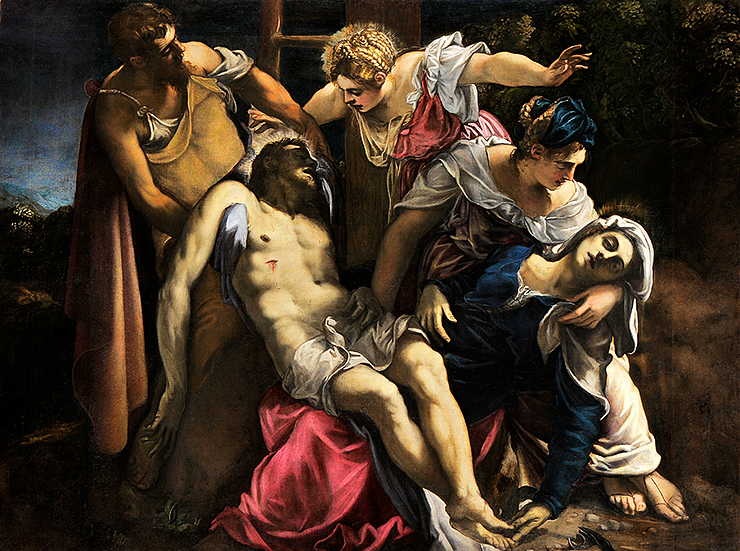When my children were young, my parish installed a new crucifix behind the altar. It replaced a rather Protestant-looking wooden cross on which was hung a much smaller corpus carried in at the start of Sunday Mass.
Carved in Italy, the new crucifix was life-sized and detailed, and it caught one’s eye immediately. It also was not aloft, nearer to the ceiling than the people. It was at our level. After Mass, I brought my 3-year-old daughter to see it up close. She immediately wanted to pat the wound on Jesus’s foot where the blood streamed from the nail holding him to the wood.
This instinct to touch reminded me of the steady stream of worshippers at the Cathedral of Our Lady of the Angels who are already burnishing the foot of the crucified Christ with their touches and their kisses.
In Washington, D.C., right now there is a stunning exhibition of the works of Tintoretto, a brilliant artist of 16th-century Venice. One painting is just after the Crucifixion, with Jesus brought down from the cross. It is a scene of great drama, with Mary, his mother, almost swooning with grief as she reaches out to touch the foot of her dead son.
There is in Catholic iconography this need to portray the wounds of Christ, to touch them, to make them tangible. We don’t just want to talk about the Blood of the Lamb, we want to touch it. It brings God closer to our mortality, to our pain.
Cardinal Luis Antonio Tagle gave an emotional talk at the start of the Vatican’s recent summit on sexual abuse in the Church in which he urged the cardinals and bishops in attendance to listen to the victims, to talk to the survivors as if touching the wounds of the crucified Lord.
“Our people need us to draw close to their wounds and acknowledge our faults if we are to give authentic and credible witness to our faith in the Resurrection,” he said.
All of us are wounded, and in the wounds of Jesus we see a God who is not remote but who knows, who understands.
The Gospel writers wanted to make clear the reality of the Lord’s suffering and death. The cries to God, the thirst, the final breath, the pierce of the lance and the blood and water.
The Son of God, the Messiah, put to death in a most ignominious way — a common criminal hung on the cross to die slowly in front of a crowd of onlookers. The spotless victim, the perfect sacrifice, had died that we might be healed of our wounds, that we might be saved.
This is why we venerate the cross on Good Friday, commemorating the wood on which hung our salvation.

A woman venerates the crucifix at the Cathedral of Our Lady of the Angels on Good Friday last year. (VICTOR ALEMÁN)
Yet all of this would only be a rather strange death cult if it ended here. As St. Paul writes, if Christ has not risen, then we are the most foolish of men. How could we know that we had been saved if not for the Resurrection?
The resurrection of the Lord is the happy ending of which we are assured. The finality of death is not final. As T.S. Elliot writes, “In our end is our beginning.” What seemed like the end of the life of the mortal Jesus, the agony, the blood, the grieving mother, the stunned and frightened followers, was only the prologue to something far greater.
One thinks of the various Resurrection accounts in Scripture. While they differ in certain details, what comes through is the struggle to comprehend, the shock, the surprise.
In the retrospective recalling in the Gospels, Jesus seems to make plain what was to happen, but it only became clear looking back.
Hearing the women tell the story that the tomb was empty, hearing the two disciples talking about the encounter with Jesus on the road to Emmaus, one can imagine the incomprehension, even disbelief, that these stories were true. And yet those encounters with the risen Lord changed everything, and for all time.
This is Easter: The Lord truly rose, and because he rose, our hope is not in vain. Easter is only understood in the context of Good Friday, and Good Friday is only understood in the context of Easter.
What much of contemporary society calls Easter is really without context and without meaning. The comedian Jim Gaffigan skewers it appropriately: Eggs and a bunny. Some chocolate, too.
Society can’t comprehend the redemptive, salvific power of suffering.
The truth be told, sometimes I can’t either. And so it comes down to touch again. Not Mary touching the foot of her dead son, but Thomas invited by the living Lord to touch the lance wound and believe. And all that remains to be said is, “My Lord and my God.”
Greg Erlandson is editor-in-chief of Catholic News Service (CNS).
SPECIAL OFFER! 44 issues of Angelus for just $9.95! Get the finest in Catholic journalism with first-rate analysis of the events and trends shaping the Church and the world, plus practical advice from the world’s best spiritual writers on prayer and Catholic living, along with great features about Catholic life in Los Angeles. Subscribe now!

